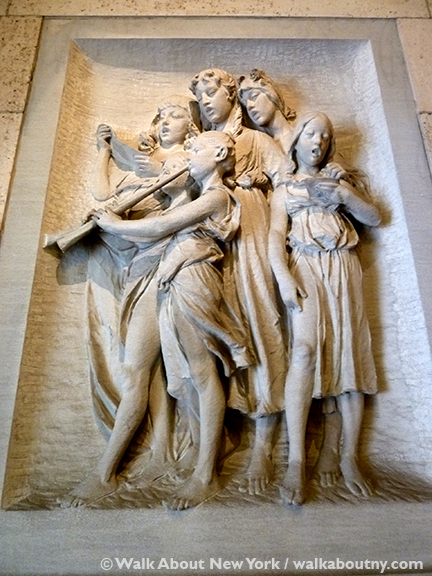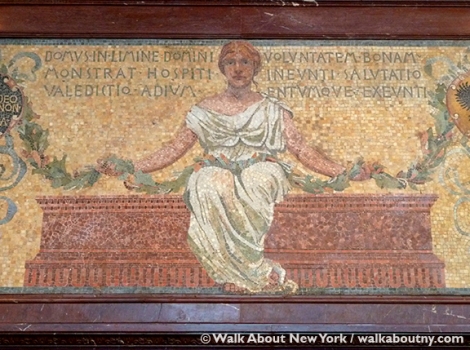“The bits and pieces of history that chronicle the four-generation saga of the Vanderbilt Family are scattered everywhere like a broken string of pearls …”
—from 1989’s Fortune’s Children by Arthur T. Vanderbilt II

The Vanderbilt Gates now lead to Central Park’s Conservatory Garden.
Tales of the Vanderbilt family have formed a pillar of New York historical legend for 150 years. Their roots were modest. Cornelius Vanderbilt, the family patriarch known as the Commodore, was born and raised in a Staten Island farmhouse. First with a ferryboat service on New York Harbor and then with a railroad empire stretching across the country, Vanderbilt grew wealthy. His heirs did the best thing possible with the money; they spent it! One very conspicuous way was on lavish houses; they built along Fifth Avenue in New York and Bellevue Avenue in Newport, RI. However, less than 50 years after the Commodore’s death, the last of his descendant’s ten Fifth Avenue mansions had been demolished.

A gold-leafed shell tops the Vanderbilt Gates.
In 1877 the Commodore willed his namesake and grandson, Cornelius Vanderbilt II (1843–1899), a $7 million inheritance. In the early 1880s Cornelius II used some of that money to buy townhouses on the northwest corner of Fifth Avenue and West 57th Street. This is where he would commission George B. Post to design a red brick and limestone château; leading artists of the era, such as John LaFarge, Augustus Saint-Gaudens, Philip Martiny, Frederick W. MacMonnies and others, were engaged to decorate its interiors.

The Vanderbilt Gates are truly monumental.
The Vanderbilts were a competitive clan. Cornelius II’s wife was responsible for dictating that the interiors be lavish. In Fortune’s Children Arthur T. Vanderbilt II tells us that it was “common belief that Alice Vanderbilt set out to dwarf her sister-in-law’s Fifth Avenue château, and dwarf it she did.” That sister-in-law was Alva, wife of Cornelius II’s brother William Kissam Vanderbilt. Alva’s French Renaissance-style château was completed in 1883 at 660 Fifth Avenue, on the northwest corner of West 52nd Street.

The Vanderbilt’s “Six Girls with Musical Theme” 1893 by Karl Bitter (1867–1915)
“I want to dominate the Plaza!” With that exclamation, Cornelius II expanded and renovated his home in 1893. The Plaza he was referring to was the formal entrance leading to Central Park. We know it today as Grand Army Plaza. After buying five more townhouses on West 58th Street he demolished them and rehired George B. Post. Not surprisingly, the house was built for show, not for comfort. In Fortune’s Children Arthur T. Vanderbilt II wrote, “visitors found the mansion chilly and uncomfortable, built for social functions, not for living.” The expanded house contained 137 rooms; 37 of which were bedrooms. It had 16 baths, a library, several salons, a dining room that doubled as an art gallery, a smoking room and an expanding ballroom.

“Six Girls with Musical Theme” detail.
Cornelius II enjoyed his enlarged mansion for but a short time; he died unexpectedly in 1899. On the morning of September 12, 1899, Cornelius II bolted upright in bed; he called out, “I think I’m dying.” A short time later he died of a brain hemorrhage. Alice went into mourning. The glittering parties came to an end; the house was shuttered and the towering gates were locked. After her husband’s death, Alice Vanderbilt (1845–1934) lived on at One West 57th Street until 1926; that was the year that she sold it to Braisted Realty Corporation for $7 million. The largest private residence ever built in New York City then disappeared from the cityscape.
Luckily, a few elements from Cornelius and Alice’s showplace have survived; through them we get a glimpse of the opulent life they led. You enjoyed today if you know where to look in New York City.

The Vanderbilt’s “Seven Boys with Plumes” 1893 by Karl Bitter (1867–1915)
The carriages of Cornelius and Alice’s guests would have entered the grounds from West 58th Street by way of monumental, wrought-iron gates. Designed by George B. Post (1837–1913), the gates were forged in Paris in 1894 by Peregotte & Dauvillier. In 1939 the gates were gifted by Gertrude Vanderbilt Whitney, daughter of Cornelius II and Alice and founder of the Whitney Museum of American Art, to Central Park. They were installed at the Fifth Avenue entrance to the Park’s Conservatory Garden at East 105th Street. A 1908 New York Times article offered this description, “two immense wrought-iron gates, twenty feet high and surmounted by great lamps.”

“Seven Boys with Plumes” detail.

“Seven Boys with Plumes” detail of a plume of title.
Interrupting Alice’s mourning were two tragic family events that caused the gates to be unlocked. The first was for the memorial to Alfred Gwynne Vanderbilt, Alice and Cornelius’ son, who went down with the Lusitania in 1915. The second was in 1925 for the funeral of another son, Reginald, the playboy and father of Gloria Vanderbilt (mother of Anderson Cooper), who drank himself to death.

The Vanderbilt Mantlepiece now at Metropolitan Museum of Art.
After driving through the wrought iron gates, guests would alight from their elegant black carriages under the porte cochere. Visitors would notice six lovely sculptural reliefs there; they decorated the piers of the porte cochere’s columns. Karl Bitter, a German and the preferred sculptor of the entire Vanderbilt family, carved them; he was inspired by works of the Italian Renaissance. Each limestone panel showed groupings of either boys or girls in welcoming, usually musical tableaux. When One West 57th Street was demolished, two of the six were saved. Today they can be seen flanking the revolving door to the lobby of the Sherry-Netherland Hotel. The other four bas-reliefs have disappeared without a trace.

The Vanderbilt Mantlepiece detail.
Guests would be ushered through the front door and into the entrance hall of Cornelius and Alice’s house. The hall was dominated by an elaborate mantelpiece. Designed by John LaFarge in reddish brown marble, mosaic, oak, and cast iron the mantelpiece was flanked by marble caryatids; they are the work of Augustus Saint-Gaudens, the preeminent American Beaux-Arts sculptor. The two classical caryatids support the wide entablature with their heads and upraised arms. Each caryatid is an allegory; Amor (Love) is on the left and Pax (Peace) is on the right.

The Vanderbilt Mantlepiece detail.

The Vanderbilt Mantlepiece left mosaic detail.

The Vanderbilt Mantlepiece right mosaic detail.
Above the mantelpiece Mr. LaFarge designed a mosaic; it depicts a classically-robed, garland-holding maiden seated on a bench. The master of the house supplied the Latin inscription on either side of the maiden. Its translation is as follows, “The house at its threshold gives evidence of the master’s good will. Welcome to the guest who arrives; farewell and helpfulness to him who departs.”

The Vanderbilt Mantlepiece left caryatid (Amor) detail.
The hovering medallions on either side of the central figure catch up the garland’s ends. The right one shows the Vanderbilt family’s coat of arms, and the left one bears the lion rampant of the Vanderbilt crest and the Latin motto, DEO NON FORTUNA (By God’s Grace Not Fortune’s). Notice the acorns—symbols from the Vanderbilt arms—are intertwined with the foliage at regular intervals.

The Vanderbilt Mantlepiece right caryatid (Pax) detail.
When the house was renovated in the early 1890s the mantelpiece was relocated to the second-floor, family sitting room. In 1925 Alice decided that the encroachment of office buildings on her home had become too much to tolerate. She sold the house. Before it was demolished she made a gift of the mantelpiece and some paintings to the Metropolitan Museum of Art. Currently the mantelpiece can be seen in the Museum’s American Wing. Go! Marvel at its grandness.

The Vanderbilt Mantlepiece firescreen detail.
